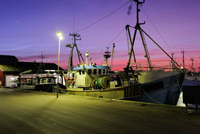Sea Level's Rise Focus of Summit
Projections of dramatic change draw group to UCSD to strategize about vulnerabilities of affected areas
LA JOLLA — Climate researchers, social scientists and policy experts from across the Pacific Rim convened at UC San Diego last week to get ahead of seas projected to rise so dramatically that they could create some of the most visible effects of global warming.
Representatives from about 20 leading research universities and nonprofit groups in South Korea, Russia, Indonesia and elsewhere met to prepare for potentially catastrophic effects on 200 million people and trillions of dollars of coastal assets.
Sea levels off most of California are expected to rise about 3 feet by 2100, according to recent projections by the National Research Council. Higher seas create challenges for port cities from San Diego to Singapore, including the potential for dramatically increased damage to coastal roads, homes and beaches — especially during storms.
“All future development has to be assessed in regards to future rises in sea level,” Steffen Lehmann, professor of sustainable design at the University of South Australia, said during the conference. “Reducing the vulnerabilities of urban (areas) is the big topic, the big task ahead of us now.”
Potential responses include managing a retreat from eroding bluffs and reshaping coastal areas to buffer development from higher water levels. “The missing link (is) between the science and those guys in planning offices and architecture firms and city municipal offices,” Lehmann said.
David Woodruff, director of the University of California San Diego’s Sustainability Solutions Institute, organized the workshop to address that problem with cross-disciplinary discussions that move toward international action.
“We are trying to affect societal change,” he said. “The sooner we start scoping options, the less expensive it will be to save current infrastructure.”
The workshop was sponsored by the Association of Pacific Rim Universities, a consortium of 42 leading research institutions. Participants drafted a report about rising sea levels for top university leaders so they can make the topic a priority with national-level leaders around the Pacific Rim.
“I really think universities can play a key role,” said UC San Diego’s Charles Kennel. “They are right at the pivot point between connecting knowledge to action. … One of the places they need to transfer their knowledge to is adaptation to climate change.”
A warming climate causes sea levels to rise primarily by heating the oceans — which causes the water to expand — and by melting land ice, which drains water to the ocean. Sea levels at any given spot depend on a complex interaction of factors, such as ocean and atmospheric circulation patterns and tectonic plate movements.
Global sea level has risen about 7 inches during the 20th century, the National Research Council said.
While sea-level-rise projections aren’t a sure thing, they are widely accepted by mainstream scientists. Skeptics see it as a waste of money to plan for problems that may not materialize for decades, or may be more modest than predicted.
Read more on the Union-Tribune San Diego.
KUOW (NPR) Radio - Ray Hilborn on Overfishing: How Big Is The Problem?
Fish is a significant source of protein in the human diet; around 90 million tons are caught every year. Are some fisheries in danger of collapse? What species are being managed the right way? UW professor and fisheries expert Ray Hilborn talks to David Hyde about his new book "Overfishing: What Everyone Needs To Know."
Listen to the full interview here via KUOW NPR - 94.9 FM (Seattle).
Ray Hilborn is a professor of fisheries at the University of Washington. Reporter Ross Reynolds hosts this fast–paced news call–in program. Engaging, stimulating and informative – a forum where listeners have the chance to speak directly with experts on news–oriented topics. The Conversation covers the very current topics and issues of the day.
The Bite is On! Fishing for Salmon off California Coast is Best in Years
The Bite is On! Fishing for Salmon off California Coast is Best in Years

If your fishing gear has been in the garage collecting dust, now's the time to pull it out because the salmon are here, and the bite is on!
Anglers and sport-fishing charters off the California coast are returning to the docks with full boats and happy customers as the strong ocean salmon bite continues, making 2012 one of the best salmon seasons in years.Mild weather and good ocean conditions are contributing to what fishermen and Department of Fish and Game (DFG) officials hope will continue to be a robust year for ocean salmon fishing. Hopes are also high for big returns to California rivers this fall.“Thanks to the favorable ocean conditions and plentiful food, all the reports we are receiving from the coast are very positive,” said DFG Northern Regional Manager Neil Manji. “The charter boats are coming back early enough to make two trips a day because everyone has been catching their limits.”The daily bag and possession limit is two salmon per person and the minimum size limit is 20 inches.
To find out more visit the California Department of FIsh and Game.
International Efforts to Assess the Status of Pacific Sardine Stocks
Fisheries Resources Division
Scientists from the U.S. and Canada are working together to strengthen Pacific sardine stock assessments. SWFSC scientists conduct regular Pacific sardine stock assessments to determine harvest guidelines for this economically important species. In May, Canadian and NMFS scientists, together with independent experts, considered how to integrate data from Fisheries and Oceans Canada’s West Coast Vancouver Island swept-area trawl survey (WCVI) into the Pacific sardine stock assessment.
Preliminary results of the review suggest that including the Canadian survey data could strengthen and enhance the U.S. stock assessment in the future, especially as the survey evolves. Inclusion of the Canadian survey into the assessment may provide valuable insights into the northern most extension of the Pacific sardine population, the largest size classes, and the timing and extent of migration during different years. The Pacific Fishery Management Council will consider whether to incorporate the Canadian data into the U.S. stock assessment based on the independent review results. The earliest the data could be incorporated would be for the 2014 fishing season.
For more information on SWFSC’s coastal pelagic research programs, please visit the Fisheries Research Division
Management information on Pacific sardine in U.S. waters may be found at the Council's website: http://www.pcouncil.org/coastal-pelagic-species/background-information/
The 10 Most Dangerous Jobs in the U.S.
By Travers Korch | Bankrate.comPaper cuts are the worst. That is, until you put things in perspective and realize that for many of us, our jobs require very little actual physical danger. From the relatively exotic to the seemingly mundane, certain occupations carry an underlying danger that can reach up to 116 fatalities per 100,000 workers.According to the Bureau of Labor Statistics' most recent figures, there were 4,547 fatal occupational injuries in 2010, or four fewer than reported in 2009. The majority of these injuries occur in a handful of sectors representing the most dangerous ways to earn a living in the country.But for the rest of us, we all know that getting a paper cut right where your finger bends is still pretty terrible.Job: Fishing Risk factors: The producers of "Deadliest Catch" don't need to create much artificial drama, as fishers and fishing workers have -- on average -- the most dangerous jobs in the country. Malfunctioning gear, inclement weather and transportation incidents all factor into the fact that this profession has the country's highest fatality rate, a distinction it has held since 1992. Fatality rate: 116 per 100,000 workers; 29 totalAverage annual salary: $25,590Job: Logging workers
Risk factors: The producers of "Deadliest Catch" don't need to create much artificial drama, as fishers and fishing workers have -- on average -- the most dangerous jobs in the country. Malfunctioning gear, inclement weather and transportation incidents all factor into the fact that this profession has the country's highest fatality rate, a distinction it has held since 1992. Fatality rate: 116 per 100,000 workers; 29 totalAverage annual salary: $25,590Job: Logging workers Risk factors: Total logging fatalities in the U.S. increased from 36 in 2009 to 59 in 2010, with more than half of the incidents resulting from being struck by an object. Dangers abound when you spend most of your days outside with heavy machinery, frequently bad weather and occasional high altitudes. Fatality rate: 91.9 per 100,000 workers; 59 totalAverage annual salary: $32,870Job: Aircraft pilots and flight engineers
Risk factors: Total logging fatalities in the U.S. increased from 36 in 2009 to 59 in 2010, with more than half of the incidents resulting from being struck by an object. Dangers abound when you spend most of your days outside with heavy machinery, frequently bad weather and occasional high altitudes. Fatality rate: 91.9 per 100,000 workers; 59 totalAverage annual salary: $32,870Job: Aircraft pilots and flight engineers Risk factors: Though pilots are often financially compensated for the inherent dangers and responsibilities of their jobs, no amount of money can change the fact that it's a long way down. It's no surprise transportation accidents, including crashes, were a leading factor in the rate. Fatality rate: 70.6 per 100,000 workers; 78 totalAverage annual salary: $118,070 for airline pilots and $76,050 for commercial pilots Job: Farmers and ranchers
Risk factors: Though pilots are often financially compensated for the inherent dangers and responsibilities of their jobs, no amount of money can change the fact that it's a long way down. It's no surprise transportation accidents, including crashes, were a leading factor in the rate. Fatality rate: 70.6 per 100,000 workers; 78 totalAverage annual salary: $118,070 for airline pilots and $76,050 for commercial pilots Job: Farmers and ranchers Risk factors: Working the land may be one of the oldest professions, but new efficient technology has done little to make the job any safer. Long hours and close, consistent contact with heavy machinery and equipment represent the bulk of injuries and fatalities on the job, which is largely represented by transportation incidents. Fatality rate: 41.4 per 100,000 workers; 300 totalAverage annual salary: $60,750
Risk factors: Working the land may be one of the oldest professions, but new efficient technology has done little to make the job any safer. Long hours and close, consistent contact with heavy machinery and equipment represent the bulk of injuries and fatalities on the job, which is largely represented by transportation incidents. Fatality rate: 41.4 per 100,000 workers; 300 totalAverage annual salary: $60,750
Job: Mining
 Risk factors: Heavy machinery, close quarters and explosive materials all play into mining's high fatality rate, which took into account the 2010 incidents of the Deepwater Horizon oil rig and the Upper Big Branch Mine in West Virginia. Mining machine operators have an even higher rate, at 38.7 per 100,000 workers, or 23 fatalities in total. Fatality rate: 19.9 per 100,000 workers; 172 totalAverage annual salary: $37,230 to $89,440
Risk factors: Heavy machinery, close quarters and explosive materials all play into mining's high fatality rate, which took into account the 2010 incidents of the Deepwater Horizon oil rig and the Upper Big Branch Mine in West Virginia. Mining machine operators have an even higher rate, at 38.7 per 100,000 workers, or 23 fatalities in total. Fatality rate: 19.9 per 100,000 workers; 172 totalAverage annual salary: $37,230 to $89,440
Read the rest of the article on Yahoo.com
Website - Seafood Health Facts: Making Smart Choices

The Seafood Health Facts website was recently updated to included a link to customizing seafood consumption information and also to provide guidance to a broader range of consumers.
The Seafood Health Facts site includes current information on seafood nutrition/health, safety and market topics. It will help answer many commonly asked seafood safety questions that consumers and patients often ask health care providers and retailers.
Bookmark this great new resource! It is a handy tool to help you become seafood savvy. Check it out at seafoodhealthfacts.org.
